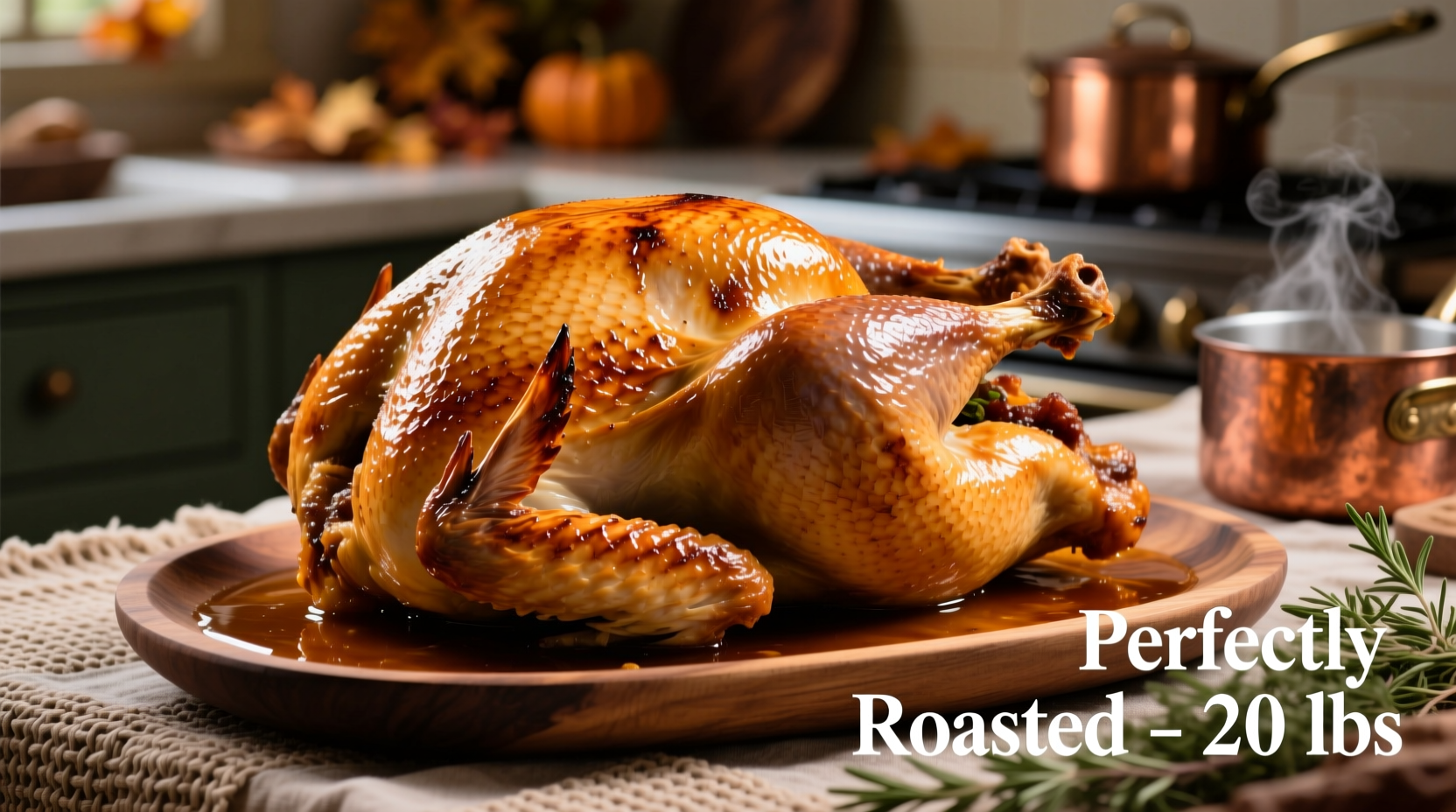A 20 lb turkey requires 4½ to 5 hours of roasting at 325°F, with an internal temperature reaching 165°F in the thickest parts of the breast and thigh. Proper thawing takes 4-5 days in the refrigerator, and resting for 30-45 minutes after cooking ensures juicier meat.
Roasting a 20-pound turkey perfectly seems daunting, but with precise timing and technique, you'll serve a moist, flavorful centerpiece for your holiday feast. This comprehensive guide delivers exactly what you need: science-backed cooking times, foolproof temperature targets, and professional chef techniques adapted for home kitchens. No more dry turkey or last-minute panic when guests arrive.
Why Size Matters: The Science Behind Cooking Large Turkeys
Understanding heat transfer in a 20 lb bird is crucial. Larger turkeys take disproportionately longer to cook than smaller ones due to the square-cube law—as weight increases, volume (and cooking time) grows faster than surface area. This explains why a 20 lb turkey needs nearly double the time of a 10 lb bird despite being only twice the weight.
| Turkey Weight | Estimated Roasting Time (Unstuffed) | Estimated Roasting Time (Stuffed) |
|---|---|---|
| 10-14 lbs | 3 to 3¾ hours | 3¼ to 3¾ hours |
| 14-18 lbs | 3¾ to 4¼ hours | 4 to 4¼ hours |
| 18-20 lbs | 4¼ to 4½ hours | 4½ to 5 hours |
| 20-24 lbs | 4½ to 5 hours | 5 to 5¼ hours |
Source: USDA Food Safety and Inspection Service (official guidelines)
Phase 1: Critical Preparation (3-5 Days Before Cooking)
Safe Thawing Methods
Never thaw a 20 lb turkey at room temperature—this creates dangerous bacterial growth zones. Your options:
- Refrigerator method (recommended): Allow 24 hours for every 4-5 pounds. A 20 lb turkey needs 4-5 days in a refrigerator set at 40°F or below.
- Cold water method: Submerge in cold water (changing water every 30 minutes), allowing 30 minutes per pound. A 20 lb turkey requires about 10 hours.
Brining for Maximum Juiciness
For a turkey this size, dry brining outperforms wet brining by creating a more concentrated seasoning effect without waterlogged meat. Apply 1 tablespoon of kosher salt per 5 pounds of turkey weight (about 4 tablespoons total) evenly under the skin and on the surface 24-48 hours before roasting. This allows salt to penetrate deeply while drying the skin for superior browning.
Phase 2: Roasting Process (The 5-Hour Journey)
Preheating and Setup
Preheat your oven to 325°F—not higher. While many recipes suggest starting at 425°F, this risks over-browning the exterior before the interior cooks through on a 20 lb bird. Position the turkey on a rack in a roasting pan with the breast side up. Insert an oven-safe meat thermometer into the thickest part of the breast, avoiding bone.

Temperature Monitoring: Your Secret Weapon
Set two alarms: one for when the breast reaches 150°F (about 3½ hours in), and another for 160°F (about 4¼ hours). The temperature will continue rising 5-10 degrees during resting. The USDA confirms 165°F as the safe minimum internal temperature, but removing at 160°F prevents overcooking.
When to Baste (And When Not To)
Limit oven door openings to maintain consistent temperature. Basting more than twice significantly extends cooking time. Instead, shield the breast with foil after 2½ hours if browning too quickly—this technique, used in professional kitchens, prevents the thinner breast meat from drying out before the darker thigh meat finishes.
Phase 3: The Critical Resting Period
Why Resting Isn't Optional
For a 20 lb turkey, resting for 30-45 minutes redistributes juices throughout the meat. Cutting too soon releases precious moisture onto the cutting board. During this time, cover loosely with foil but avoid sealing tightly, which can make skin soggy.
Carving Techniques for Presentation
Start with the legs and thighs, then remove entire breast sections before slicing. This professional method ensures even slices without sawing through delicate meat. Use a sharp carving knife and steady cutting board—a 20 lb turkey yields approximately 30-35 servings, so proper technique maximizes portion quality.
Troubleshooting Common 20 lb Turkey Issues
Dry Breast Meat
Cause: Uneven heat distribution in large birds. Solution: Apply butter under the skin before roasting and tent breast with foil during the final 1½ hours of cooking. The USDA confirms that breast meat cooks faster than dark meat, requiring strategic protection.
Undercooked Thighs
Cause: Insufficient cooking time for the dense muscle tissue. Solution: If thighs haven't reached 165°F when breast is done, carefully remove breast portions and continue roasting thighs separately.
Skin Not Crisping
Cause: Moisture trapped under foil or improper temperature. Solution: For the final 30 minutes, increase oven temperature to 425°F with foil removed. Pat skin dry before roasting and avoid excessive basting.
Advanced Techniques for Exceptional Results
Reverse Searing Method
For unparalleled moisture control, try reverse searing: roast at 225°F until internal temperature reaches 145°F (about 7-8 hours), then blast at 500°F for 15-20 minutes to crisp skin. This low-and-slow approach ensures even cooking throughout the massive bird.
Temperature Mapping
Insert multiple thermometers: one in breast, one in thigh, and one near the cavity. This reveals temperature gradients across the 20 lb bird, allowing you to rotate the pan for even cooking when differences exceed 10°F.











 浙公网安备
33010002000092号
浙公网安备
33010002000092号 浙B2-20120091-4
浙B2-20120091-4